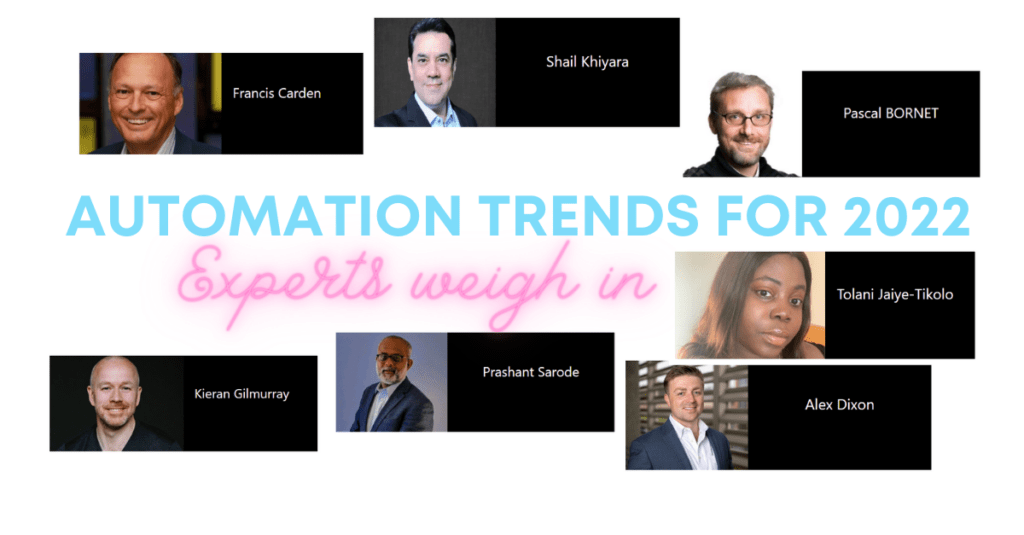We are coming to the end of 2021, a tumultuous year for Intelligent Automation.
To recap, RPA became part of the largest operating system – Windows. Salesforce and ServiceNow added RPA while Microsoft moved to the leader’s quadrant. The RPA pioneer BluePrism was set to be merged with TIBCO but now seems to be going down another path. UiPath went public and Automation Anywhere may follow suit. And finally, Open-source RPA started to gain traction.
So, if you are wondering what is in store for next year, we asked top Intelligent Automation experts what we can expect to see in 2022. Here is what they said:
- AI will rapidly move onto broader use cases WITHIN the core of the processes and applications themselves.
- Citizen Developers (or builders) will be defined in our industry more clearly (well overdue).
- IT and business alignment like never before thanks to no-code being recognized as NOT, no IT
- Rapid rise of new business applications built from scratch
- Process Mining gets upgraded to become more real time and persistent (embedded into more commercial apps OOTB).
- Consolidation in the market and commoditization of certain Automation technologies will drive 2022.
- RPA, already down a commoditization path, will enter a trifling phase where customer key buying factors will revolve around ‘enterprise automation’ – a collection of integrated technologies (not hyperautomation, not intelligent automation).
- Office of the CFO will emerge as the key driver of demand for enterprise automation technologies.
- Niche vertical plays will see a quick deflation in demand, particularly with the increasing acceleration of lessons learned from quick try & fail experiments.
- The intersecting orbit of Integration & Automation will be more pronounced in 2022, leading to broader, more holistic, end-to-end use cases that will derive increased Automation Value for the end user. This may be a stepping stone for the autonomous enterprise but the value of and reality of such an enterprise is still years away.
In 2020 and 2021, companies had to massively adopt AI and digital to make sure they could survive in a challenging environment. Some of them even thrived.
In 2022, AI needs to become closer to people. After all, AI is built by people for people. When AI becomes a commodity, the winners are the AI applications that are the closest to their users. In 2022, AI will become even more accessible to non-data scientists and no programmers leveraging drag & drop functionalities, friendly screens, and no code functionalities. AI will leverage AI to suggest and help people use or build their AI applications faster and better. AI will more systematically utilize language to engage and interact with users creating a seamless interface with technology. In addition, AI will leverage automation to enable people to focus on the most value-added and fulfilling work activities involving creativity, relationship, and strategy.
- Platforms will expand further as providers try to differentiate and simultaneously recognise companies need business workflow orchestration tools to control bots, apis, ai, ml, etc. to complete end to end automations.
- Citizen developers will grow in number beyond so called ‘professional’ developers as low-code tools develop further abstracting coding complexity.
- Firms will start to focus beyond bots – virtual assistants will start to proliferate, smart web forms will start to make sense, AI and next best action will begin to infiltrate orgs, front office automation will overtake the back office.
- Cloud platforms enable scaling and faster from zero start for those still to get into intelligent automation at scale.
- Outstanding customer journeys and personalization programs will be run by AI algorithms, software applications and bots.
- Digital Worker App will be accepted as valid app-type with well-defined app characteristics like we relate to Web App, Mobile App, or Gaming App. This will pave the way for the rapid digitization of core business models and operations powered by Human + Digital Co-Workers (aka Digital Workers).
- Automation opportunity mining will move away from being exclusive management consulting gig to management consulting aided by AI-driven process mining as data input.
- Dedicated & niche automation platforms will collide, consolidate and some will get lost in the ever-increasing size of Chinese Buffet style choice of Cloud-native services.
- We will see the first wave of Blockchainization effects on the Automation space as Bots / Digital Worker Apps mutate into Smart Contracts or Autonomous Economic Agents running for DAO/DAC.
- Cambrian explosion of DeFi (Decentralized finance) use cases, technologies, protocols & new businesses followed by re-adjustment of existing CeFi (Centralized finance) ecosystem (to make space for DeFi). DeFi+CeFi—the pie will grow, though not uniformly and preserving its geometry.
- Organizations will experience multi-vendor fatigue as RPA becomes a mere commodity that can be integrated into any platform ERP, CRM, BPM, etc.
- There is a fine line between Free RPA and Open-Source RPA. As open-source RPA continues to mature through 2022, the differentiation and usefulness become more glaring
- Vendor promises will not equal value. Organizations will not only seek vendors that can guarantee a quicker time to value but vendors with vision, innovation, and product stability
- Organizations will seek to unlock actionable insights from semi-structured and unstructured data, making Intelligent Document Processing (IDP) an imperative tool
- Everything will be available ‘as a service’ – RPAaaS, Process Discovery As a Service (PDaaS), etc. Customers will be able to shop for IA products like pampers shopping on Amazon.
- Customer-facing functions/Front Office will accelerate their consumption of Hyperautomation due to significant advances in these technologies. Humans in the Front Office (e.g. Agents) will be digitally supercharged in real-time by digital sidekicks, optimizing both customer experience (CX) and employee experience (EX). Questions around the impact of brand/human experience while using these digital tools will increase drastically.
- Automation programs will be forced to grasp technology overlap. Programs with RPA-only toolsets will increasingly adopt additional technologies (iBPMs, LCAD, iPaaS, IDP, Conversational AI, Decisions Engines, etc.) to ensure the optimal solution is delivered for the targeted business outcomes. Acquisitions and vendor consolidation are a testament to this (Mulesoft + ServiceTrace, UiPath + Cloud Elements, etc.). Each layer of this integrated Hyperautomation fabric will enable effortless Customer and Employee experiences, and drive material competitive differentiation for enterprises.
- Regarding business outcomes – automation programs will move past the agnostic time-savings metrics for intake/prioritization and automated value realization tracking of the value delivered. Business intelligence and gaining insights now-unlocked given the encapsulation of data through Hyperautomation tools will increase priority during solution design.
- Process discovery toolsets will become formally incorporated into automation delivery, and preliminary choices to fill automation pipelines. Continued remote/work-from-home will exacerbate this, and these toolsets will also be formally incorporated into process improvement/LEAN activities (if they aren’t already). Process mining will help enable event-driven workflows and JIT processing across human and digital labor (e.g. Celonis Execution Management System nomenclature).
- Cloud-delivery of automation platforms will increase, laying the grounds for semantic automation in the future. Forced migrations and neglected legacy infrastructure challenges of existing automation programs will further increase the selection of cloud-delivery models.
- My favorite – automation will continue to increasingly become more human. Automation vendors will continue to incorporate various automation execution “options” (e.g. UiPath assistant, Automation Anywhere AARI, etc.) that enable consumption of automation based on various human needs/preferences. Humans will increasingly demand automation to meet them in their existing apps, on whatever devices, and with the flexibility to interact back-and-forth. A robot for every person may not mean everyone is a citizen developer, rather, that everyone can consume and enjoy the benefits of automation.







